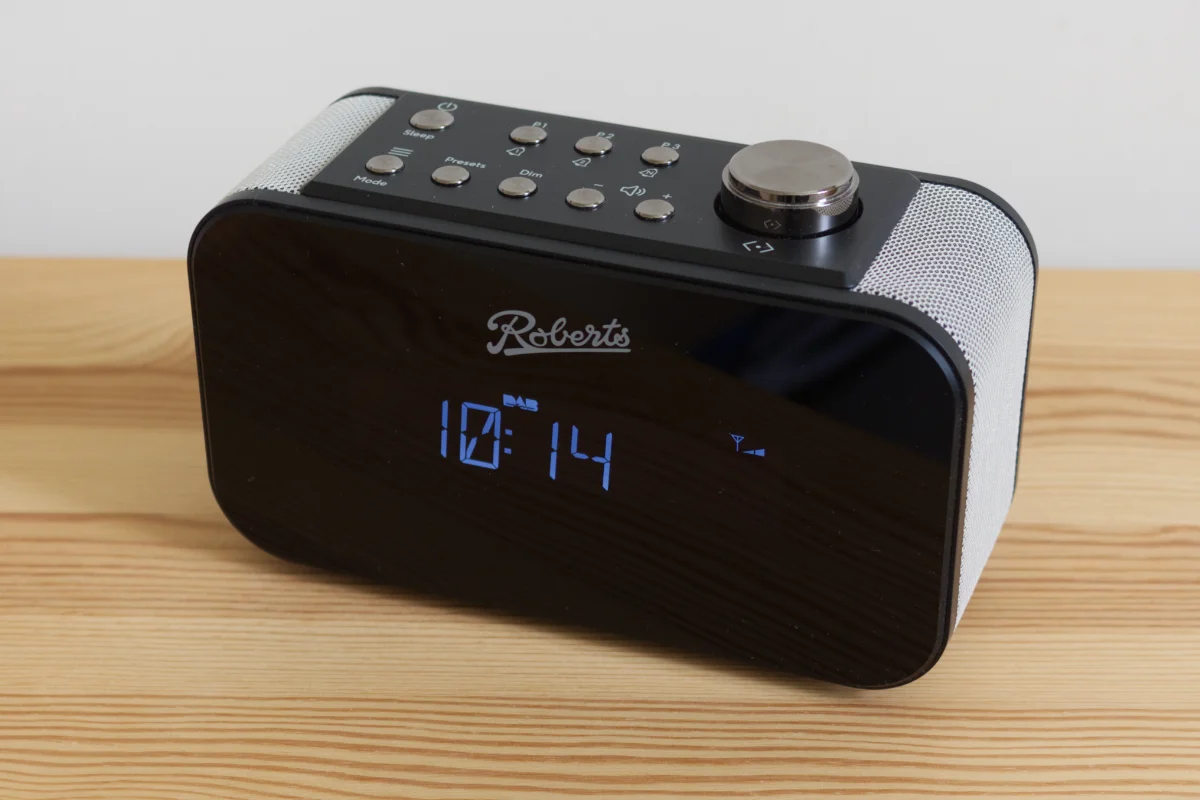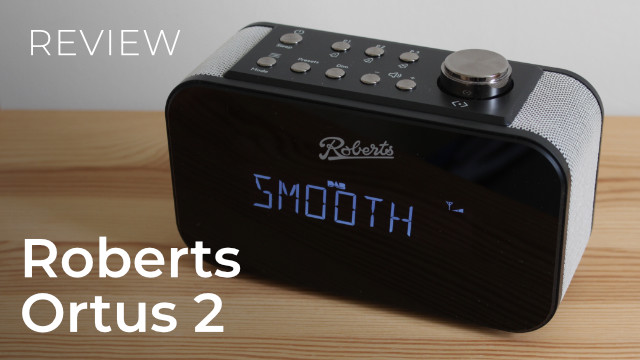The Roberts Ortus 2 is a DAB/DAB+/FM alarm clock radio. An included USB socket on the back of the radio allows for charging a smartphone without using an extra power socket. It’s available in black or white with a recommended retail price of £79.99.
Two alarms can be set with options for waking to FM or DAB stations or a buzzer. There’s also options for a sleep timer and a nap timer. This can be useful for setting an alarm to occur in a short amount of time, such as 60 minutes, without needing to set one of the normal alarms.
Features and setup
The Roberts Ortus 2 comes with a power adapter and a manual in the box. After the wire antenna was stretched out and the radio was switched on for the first time it scanned for DAB digital radio stations.
All of the digital radio stations we normally receive were found and the time was set automatically from the DAB radio. This saves time but should also ensure the clock is accurate.
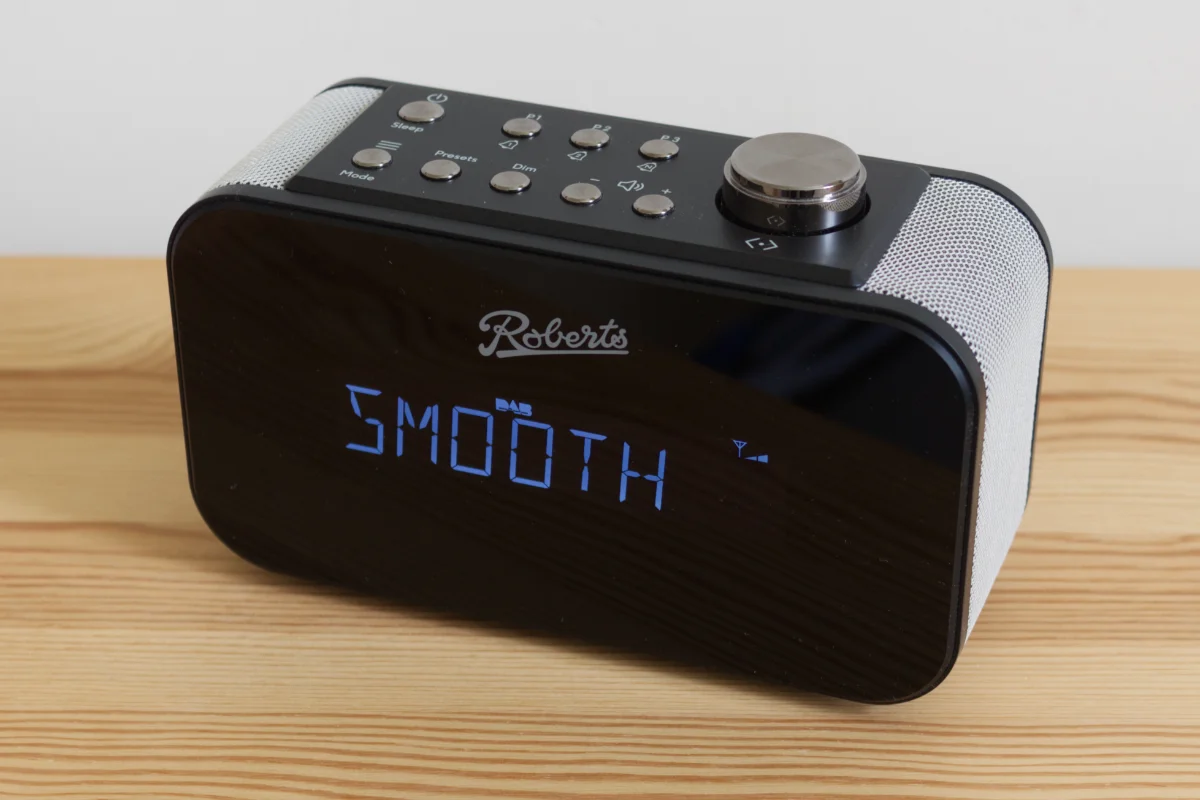
Reception of DAB/DAB+ and FM radio stations is good. The wire antennas that clock radios use can be difficult to extend and position for the best reception but we weren’t missing any stations that a normal radio with a telescopic aerial would have found. Performing a new scan for digital stations in the DAB mode is achieved easily by holding the tuning knob down.
The manual included in the box covered everything we needed to know to set up the clock radio and two alarms. However, the writing is a little small. A full user manual is available to read on the Roberts website.
A two year warranty is included with the radio. Replacement rubber feet and power adapters are available to buy from Roberts.
Sound quality
Although it looks like the radio might have speakers on the left and right behind the fabric sides the Roberts Ortus 2 actually has a single speaker on the rear. The speaker is behind a plastic grille and sounds fine despite facing away from the listener. Roberts doesn’t list a power output for the radio on its website.
The volume control covers a good range enabling very quiet listening at night. The lowest volume setting on some clock radios can feel too loud but turning the radio down to level 2 or 3 provided for sound that was just loud enough to hear.
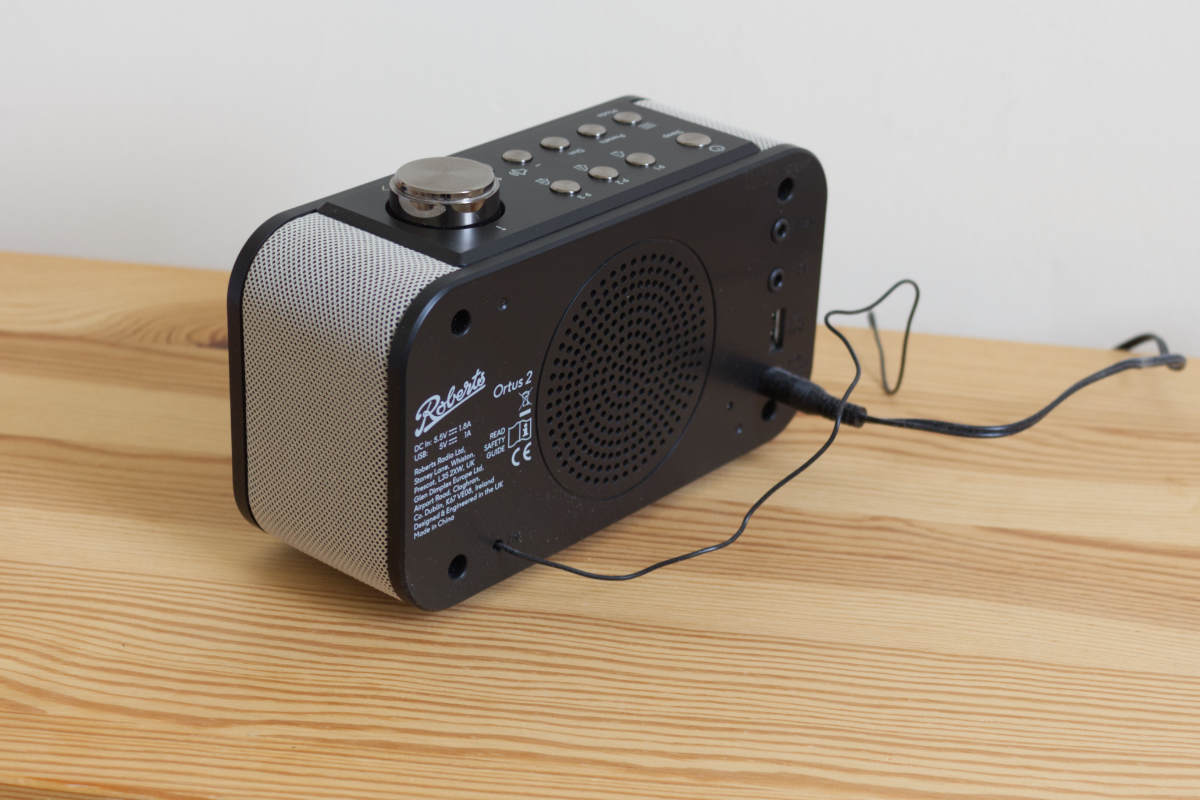
Turning the clock radio up to 20 filled a bedroom with music. It should be possible for most buyers to find a volume they are happy with for normal listening and alarms.
A headphone output is included on the back of the radio for personal listening. While the radio has a single speaker the headphone output is stereo. It’s possible to hear the stereo separation on songs like Kool and the Gang’s Jungle Boogie, but the effect is a little limited. The headphone output is sufficient for a clock radio if a little subdued. There is a setting to choose between mono and stereo output for headphones.
Podcasts, audio books and other audio from smartphones and MP3 players can be played through the clock radio’s speaker by using the auxiliary-in mode. Music sounded fine through the Aux-In mode when using an iPod Mini. The Roberts Ortus 2 does not have Bluetooth so it’s good to at least have an option to play audio from another device.
Alarms and sleep timers
The Roberts Ortus 2 has two alarms which can be set to use either a DAB/DAB+ station, FM station or the buzzer. The alarms can be used once, daily or on weekdays or weekends. This could be handy if you would like to wake up at 6.30am on weekdays to BBC Radio 4 and 7am on weekends to Classic FM.
Alarms can be set to sound for 30, 60, 90 or 120 minutes. The process for setting each alarm does involve a few steps. Before starting to set the alarms we found it worthwhile to save the desired stations as presets and see which volume level would be appropriate.
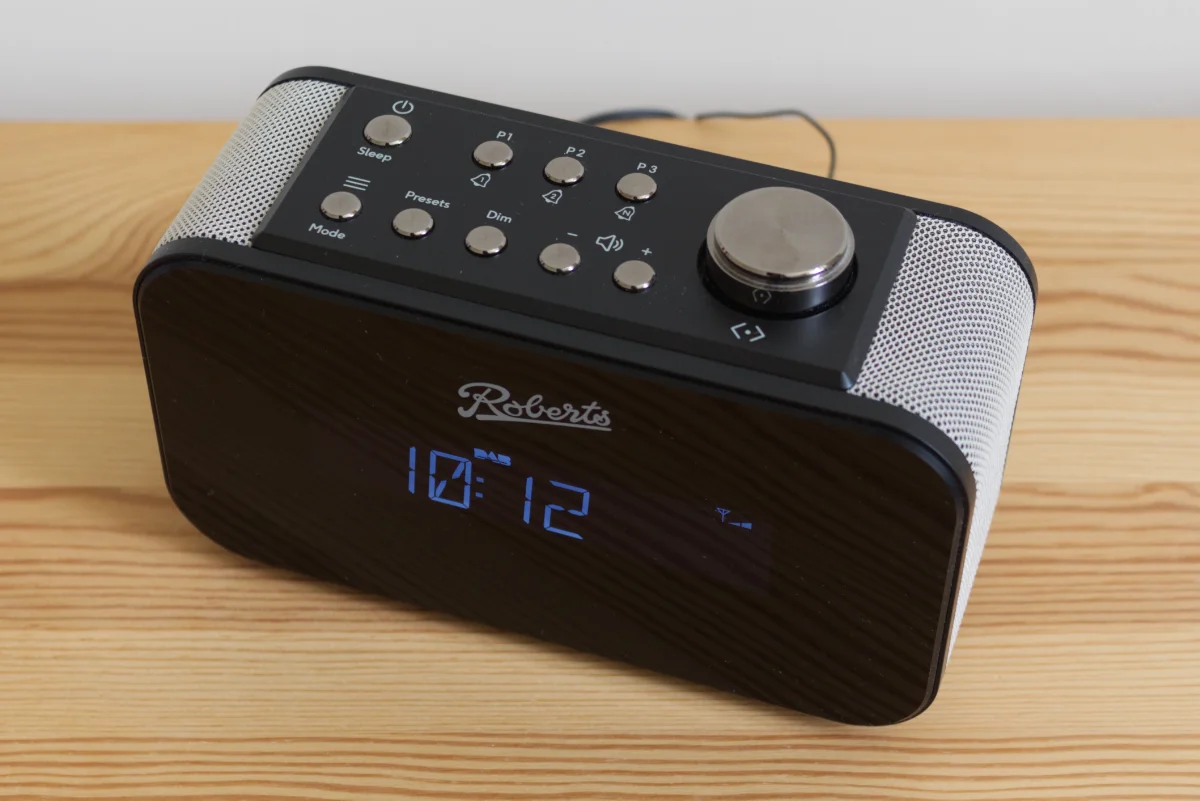
When any button other than the on/off or volume buttons is pressed the alarm should be silenced (snoozed) for a selected amount of time. Pressing the on/off button on the top left of the radio cancels the alarm.
For those who use a clock radio to wake after a nap a useful function is included. The nap timer allows an alarm to be set in up to 90 minutes without going through the normal alarm process. The sound for the nap timer is different to the normal buzzer and increases in volume as it sounds.
We found setting the alarms to be quite straightforward with the instructions, but it’s definitely worth reading the manual to understand all of the alarm options. Particular attention should be paid to the snooze function and what the buttons do when an alarm is activated.
We can’t help think that Sony’s XDR-C1DBP which is also £79 has a slightly more intuitive approach to the alarm buttons with a traditional large snooze button and a recessed alarm reset button to switch off the alarm.
User interface
All of the controls are on the top of the radio. The on/off button is slightly larger than the other buttons and found in the top left of the controls. Three preset/alarm buttons are alongside with a button for the mode/menu below. A dedicated button is assigned to the dimmer for changing the brightness of the display.
Tuning is controlled with the silver knob which turns left and right to scroll through DAB radio stations or tune up and down the FM band. The knob pushes in to select a station or confirm a selection, such as when setting up an alarm.
The volume is adjusted with separate up and down buttons. These are in the same row and the same size as other buttons and it could have been useful if there was a way to differentiate them.
This also applies to the sleep button. Using the top left button quickly becomes familiar but many similar radios would have a larger sleep button centred above the clock.
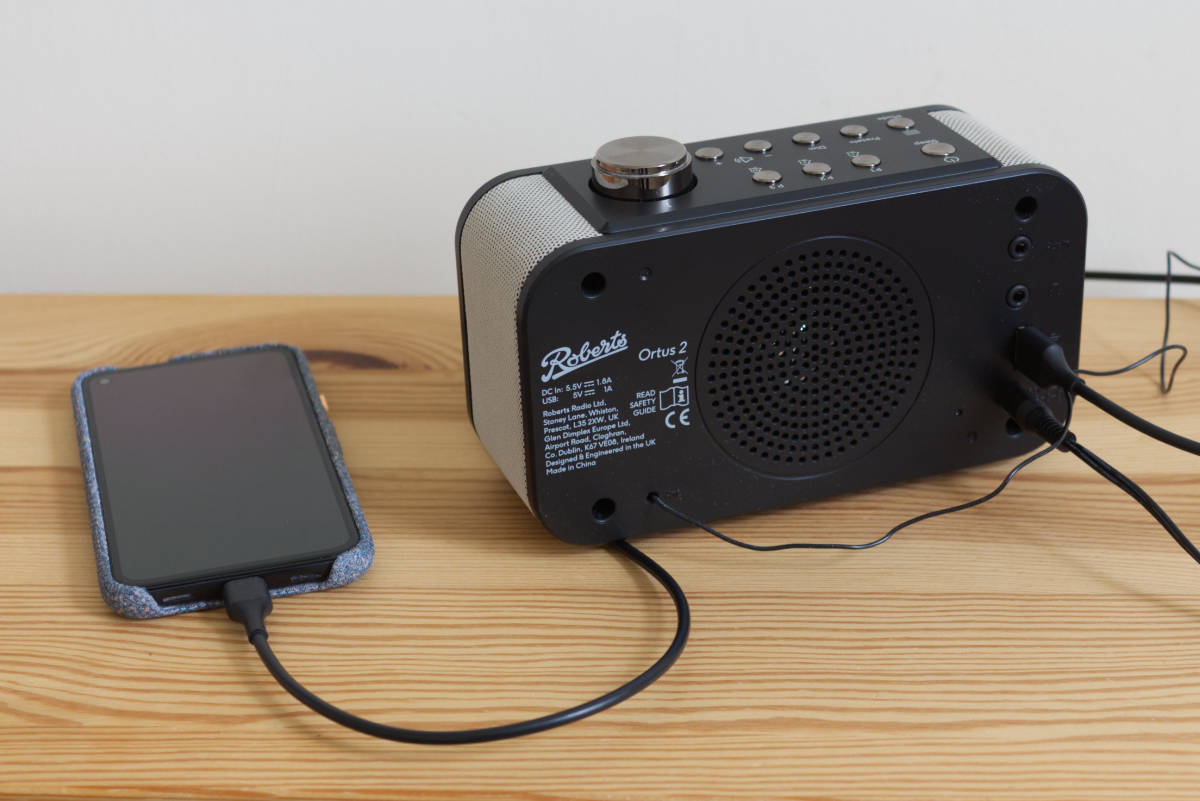
On the front of the clock radio the display shows the time or the station name. The numbers in the time are smaller than on many clock radios but will be sufficient for many users. A good range of brightness settings are available by pressing the dimmer button. Using the ‘mid’ setting worked well for us in daylight and at night.
Up to eight characters of the radio station name can be displayed. When selecting a station the name will be shown for a few seconds before the display reverts to the time display.
Setting alarms and using the menus with a fairly simple display seems like it could be tricky but we followed the included instructions and didn’t encounter any problems.
Presets 1 – 3 are easy to save and recall with the dedicated buttons. Up to 10 FM and 10 DAB presets can be saved.
Verdict
Overall the Roberts Ortus 2 is a very good DAB/FM alarm clock radio. If feels well made and the sound quality is sufficient for bedside listening. Being able to set two alarms with options for different presets or the buzzer is a great feature, although some may find alarms complex to set.
The recommended retail price of £79.99 feels fair although cheaper DAB clock radios are available. Alternatives include Roberts’ Ortus DAB Charge at the same price, which includes wireless charging for compatible phones, and the long running Siesta line from Pure.
Those who prefer a larger display for the time may wish to look at alternatives from Roberts and Pure. The sleep button is more prominent on those radios too. However, there is a lot to like about the Roberts Ortus 2.
